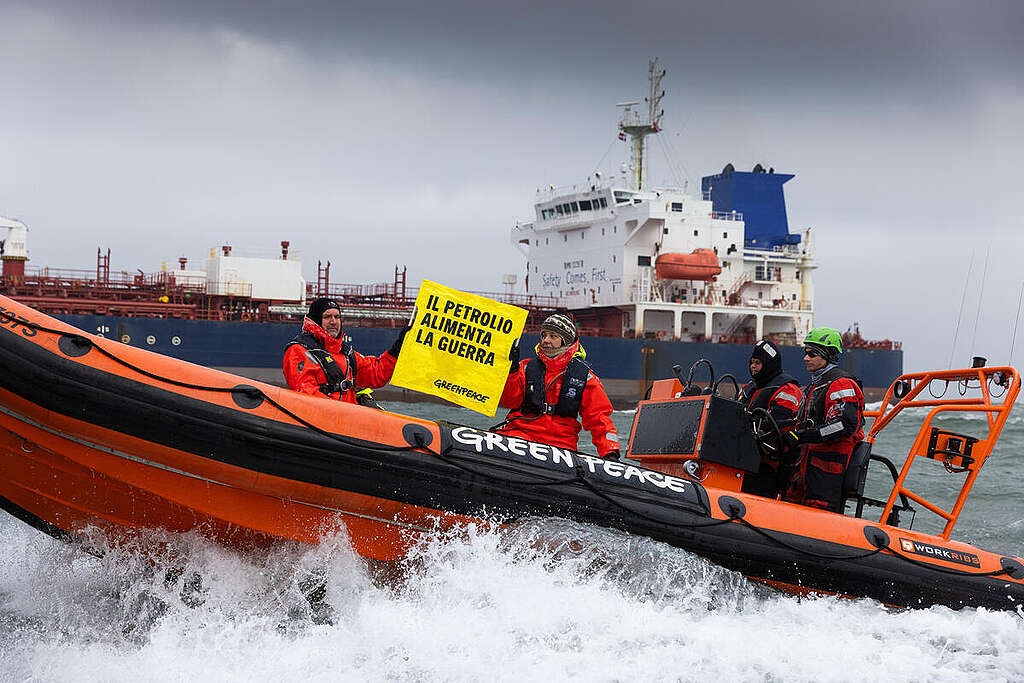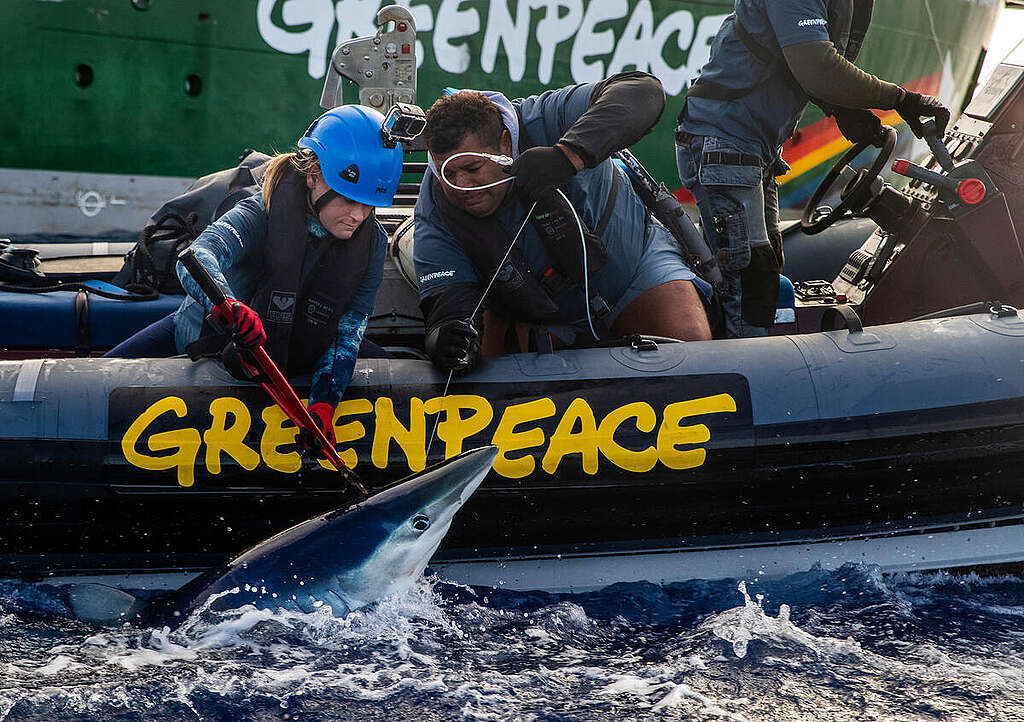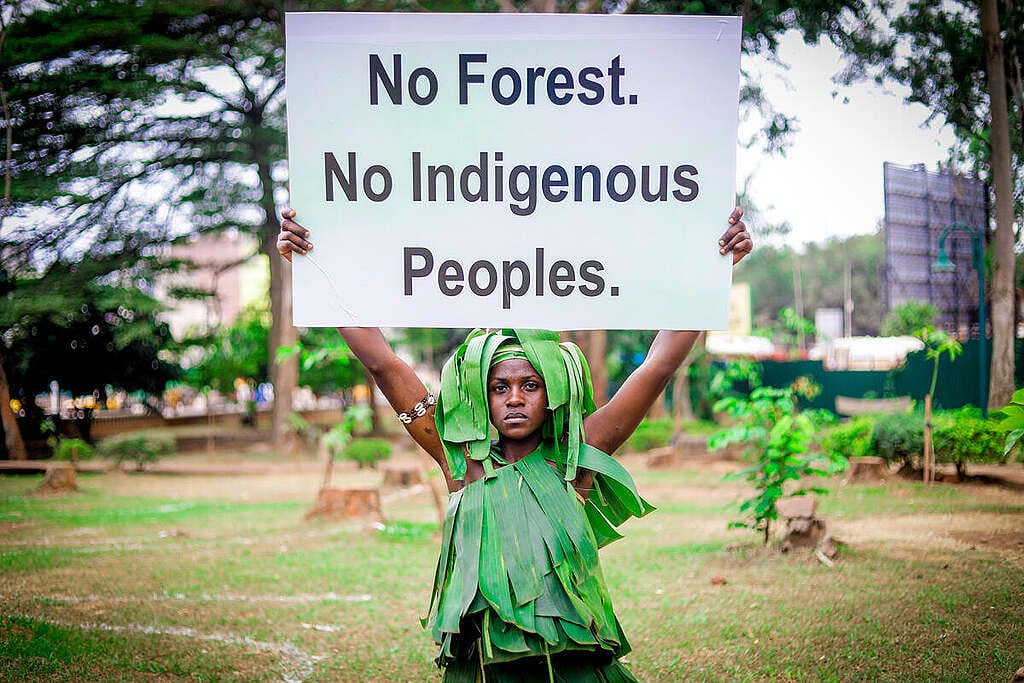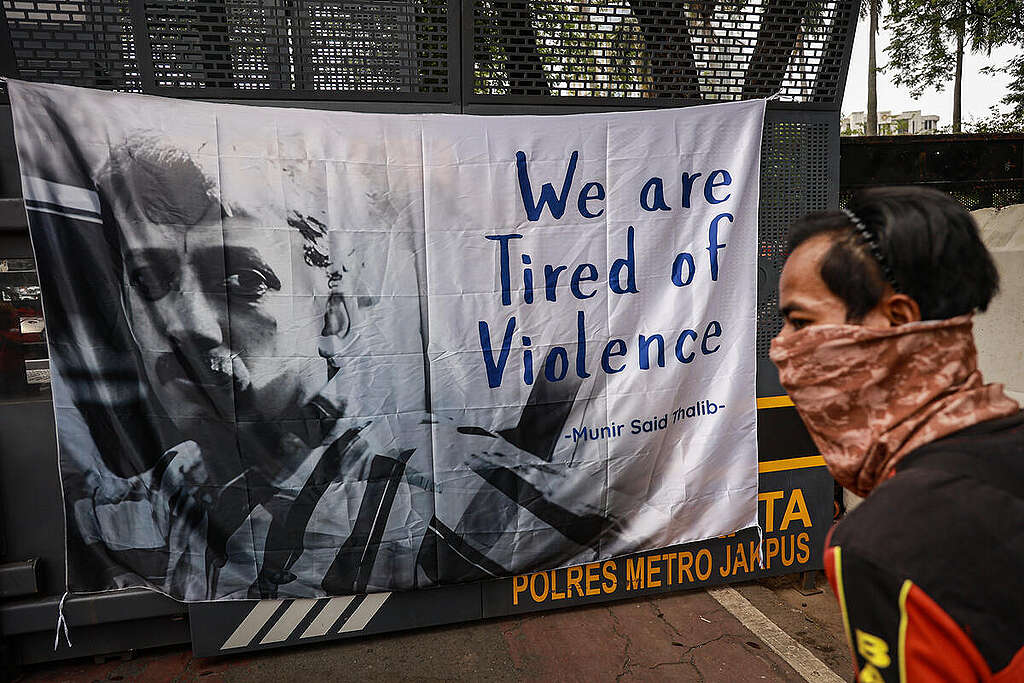Best of Greenpeace action photos 2025
Sudhanshu Malhotra
Actions and protests make up the soul of Greenpeace. Every time an activist is climbing an oil rig or holding up a banner, I hope this inspires people across the globe to also take their own action. 2025 was a highly active year, with actions taking place in various cities and seas worldwide, representing the core of Greenpeace’s values. Check out some of the best images from our action teams across the world in 2025. Volunteers from Greenpeace Brazil unveiled a 12-meter banner with the message “Respect the Amazon” during Lady Gaga’s pre-show in Copacabana on May 3. On the third annual day of Russia starting the war against Ukraine, fifteen Greenpeace activists protest against environmentally damaging Russian oil exports using run-down tankers from the so-called shadow fleet on the Baltic Sea off Rostock. From inflatable boats, the Polish, Swedish, Danish, Ukrainian and German environmentalists painted ‘RISK!’ in large yellow letters on the tankers’ side as the ‘Prosperity’ passed by. A team from Greenpeace Italy and Greenpeace Germany projected the message “Hear my cry for help” onto the Presena glacier in the Italian Alps to denounce how climate change is contributing to its melting and the consequences of losing a vital water reserve. Greenpeace activists free a blue shark caught on a longline in the Pacific Ocean. The blue shark is currently listed as “Near Threatened” globally by the International Union for Conservation of Nature (IUCN). Greenpeace Australia Pacific took action to stop an industrial longlining fishing operation in the South Pacific Ocean, seizing more than 20 kilometres of fishing gear and freeing nine sharks, including an endangered mako, near Australia and New Zealand. Greenpeace climbers install a major new work by renowned artist Anish Kapoor titled BUTCHERED onto a Shell platform in the North Sea – the world’s first artwork to be installed at an active offshore gas site. After securing a giant 12m x 8m canvas to one side of the structure, the activists hoisted a high-pressure hose on top of the canvas at a height of 16 metres above the sea. They then pumped 1,000 litres of blood-red liquid that gushed into the fabric, creating a vast crimson stain. The work is a stark visualisation of the wound inflicted on both humanity and the Earth by the fossil fuel industry, evocative of our collective grief and pain at what has been lost, but also a cry for reparation. Greenpeace Indonesia holds a photo-op “Boots to boost justice” using fishers’ boots in Muara Baru fishery port, North Jakarta. As part of World Oceans Day, Greenpeace Mexico hosted a Festival of Monumental Kites featuring various figures of marine species at Holi Beach. A group of 17 giant kites with colourful shapes that evoke the life that inhabits this great aquatic territory were displayed in the sky with the message “Without oceans there is no future”. Activists from seven countries participate in an action with Greenpeace Italy against climate-wrecking fossil gas at the new liquefied gas import terminal in Ravenna. At sea, activists reached the infrastructure and attached large banners on it reading “Burn, baby, burn” referencing President Trump’s mantra “Drill, baby, drill” alongside an image of a burning Earth flanked by the faces of US President Donald Trump and Italian Prime Minister Giorgia Meloni. Greenpeace Africa joined local and Indigenous communities for the Forest Cultural Show (Indigenous People’s Day celebration) in Yaounde, Cameroon, to learn about their environmental protection efforts, share their cultures, and explore sustainable solutions for the future. Together, they marked Indigenous Peoples’ Day. Greenpeace Africa documented how the communities apply ancestral knowledge and traditional practices to protect the forest and peatlands they depend on. The Rainbow Warrior, Greenpeace’s flagship that for decades has carried a message of defending life to every corner of the planet, is in Cartagena, Colombia, reminding us that the Amazon is not negotiable: it is respected and defended. During its passage through Colombia, on the way to COP30 to be held in Belém, Brazil, it reminded us of the urgency of stopping deforestation, protecting biodiversity and guaranteeing fair financing for indigenous peoples and local communities, who have cared for the forests for generations. In Belém, Greenpeace will demand concrete commitments: zero deforestation by 2030, direct financing and environmental governance that puts life as a priority. A few hours before the start of the COP30 in Brazil today, a Greenpeace activist walked along a highline 30 meters above the center of Madrid with a 30-square-meter banner bearing the slogan “The planet on a tightrope.” With this unprecedented action, the environmental organization seeks to demand that the governments meeting at COP put an end to fossil fuels and deforestation by 2030, halfway through what the scientific community has called the decisive decade in the face of the climate emergency. Greenpeace activists and volunteers march in the annual ‘We have had enough!’ protest for a more sustainable agriculture in Berlin. Environmental activists take to the streets with Greenpeace’s pig and cow balloons, banners, and signs. Ahead of a federal election, Greenpeace Canada’s activists projected powerful messages on the world-famous Niagara Falls: “Don’t Trump Canada”, “Elbows up” and “RESIST”. Greenpeace Canada is calling out politicians like Trump and Poilievre for spreading fear and division, while polluting industries like oil & gas seek to take advantage of a crisis they helped create. Greenpeace Canada is asking Poilievre and all political parties to protect people and the environment, not polluters and billionaires. This projection was also a solidarity statement in support of Greenpeace US, who has been found liable for more than US$660 million in the Energy Transfer SLAPP trial. The Rainbow Warrior arrives in Auckland, New Zealand, for the 40th anniversary of the bombing of the original Rainbow Warrior in Auckland by French Government agents in 1985. The Greenpeace flagship has just returned from taking action on bottom trawling on the Chatham Rise off New Zealand’s East Coast. Malaysian actress Sharifah Sofia holds a banner reads “Stop Deep Sea Mining” in front of the deep-sea vessel “Hidden Gem” which is anchored at sea in Labuan, Malaysia. The Hidden Gem, owned by AllSeas and commissioned by The Metals Company, is the deep-sea mining industry’s flagship vessel. It is currently in Labuan, Malaysia, in long-term storage. The Metals Company confirmed in late April that they have submitted the first-ever commercial mining application to the US government, with the company stating they are “ready to go”. Hundreds of people rally outside the “Summit on the Future of Energy Security”, in London. The summit is co-hosted by the UK government and the International Energy Agency and attended by officials from the pro-fossil fuels Trump administration. The demonstrators want an end to new drilling in UK waters, including new projects such as the controversial Rosebank oilfield, as well as a proper plan for transitioning the oil and gas workforce. Texte intégral (5915 mots)










The Greenpeace ship Arctic Sunrise visited the Baltic Sea as part of the European campaign against fossil gas. There, Greenpeace activists from Poland, Ukraine, Germany, Belgium, the Netherlands and Italy paid a visit to the Nord Stream gas pipelines, which used to carry fossil gas from Russia to Europe. Greenpeace Poland demands a definitive shutdown of the Nord Stream pipelines, a phase-out of Russian fossil fuels by 2027, and a full phase-out of gas across the EU by 2035 at the latest.






5 ways to disinvite plastic from your holidays
Sarah King
The holidays are here again. ‘Tis the season to hang out with (or just tolerate) family and friends, share (and maybe overindulge in) tasty meals, and enjoy festivities (or stay cozy and binge your comfort show). But no matter how you celebrate, the pressure to consume can be extreme. Capitalism’s overconsumption machine can make us think that we need to buy everything during the holidays, but as corporations pump out 430 million tonnes of plastic globally, plastic doesn’t need to get the invite to the big holiday party this year. Dodging certain holiday offerings and embracing some new anti-consumption traditions can be small but mighty acts of resistance against capitalism. Plastic is everywhere, and at this time of year it’s hiding in plain sight at your holiday gatherings. Plastic packaging is the most obvious major source of waste; however, a closer look at what many decorations and gifts are made of reveals all the other ways plastic creeps into our homes. It is in clothing, bags, bedding, childrens’ toys, holiday figurines, electronics, sports equipment, stuffed animals, cosmetics, kitchenware, furniture, the stir stick in your cocktail or mocktail — the list goes on. Why does this matter? Because plastic pollutes air, water, nature and our bodies, across its entire lifecycle. And it’s causing widespread and devastating harm. Plastic isn’t only a waste and pollution issue, it has morphed into a grave public health concern. The more plastic the industry produces, the more we’re pressured to consume, and the more pollution people and the planet are exposed to. The season of giving doesn’t have to be giving plastic disaster. We’re here to share 5 ways to beat those consumption blues. It’s never been easier to find pre-loved items in our communities. From thrift shops to antique stores, clothing swaps to flea markets, and numerous online platforms, most gift ideas you have can be found used with a bit of time and resourcefulness. Dodging big corps whenever possible isn’t only satisfying, it’s a win for your wallet and the planet. According to Earth Overshoot Day and its partners, by July 24th, 2025 humanity was using nature about 1.8 times faster than the Earth’s ecosystems are able to regenerate, so reducing demand for new materials is part of our collective consumption reduction equation. If you look at the plastic all around you today, it is set to have more than doubled in the next 25 years. Any signal we can send to big plastic producers and consumer goods companies that plastic isn’t fantastic, can help incentivize them to choose alternatives, and show governments that we support real solutions to the plastic problem. It’s a lovely time of year for meals out and coffee dates but because non-toxic, reusable containers are not yet ubiquitous, bringing your own plastic-free containers whenever possible will reduce your plastic exposure and footprint. Plastic-lined coffee cups, “bioplastic” packaging and cutlery, and even take-out containers labeled as reusable, present an opportunity for contaminating our food and our bodies with microplastics and chemicals. Various kitchenware items in our homes also contain plastic. Large plastic spatulas and spoons, sieves and strainers, cutting boards, storage containers, sippy cups, electric kettles, blenders and Teflon or coated pans all can contain or are made from plastic. Scientists have begun to uncover how using these types of items contributes to our ingestion of microplastics and exposure to potentially toxic chemicals. There’s nothing festive about a charcuterie board seasoned with microplastics. It’s not easy or affordable to do a full kitchen overhaul, but you can start by doing small changes like ditching plastic cutting boards, never heating plastic, and using stainless steel or cast iron instead of coated pots and pans. When hosting, remember reusable is best — ditch the single-use plates, cups, and cutlery and just use what you have on hand. Crowd source dishware when needed, that’s what friends are for. Who doesn’t want a little glitz at this time of year? So much of what is extra sparkly and shiny is a combination of plastic and metal, and it’s nothing but a beautiful nightmare. Glitter shows up in craft supplies, gift wrap, decorations, clothing, cosmetics, kids’ toys, costumes, party hats, and snow globes. Plastic glitter and sequins can easily shed into its surroundings, when clothing is being washed or crafts are being cleaned-up, it can shed down the drain, and when combined with paper or other materials, these products ruin recycling potential, sending them to landfill or incineration. And while some may claim to be biodegradable, it’s really not worth the potential pollution risk. Out with the old and in with the new can be a useful mantra when letting go of negative vibes or questionable habits, but when it comes to “stuff”, we all need to resist the temptation to get the newer, trendier, or upgraded item. We live in an era where we’re being given mixed messages about simplifying our lives and our relationship with material things. We’re told to buy more, but also buy better. Wide leg jeans today, skinny jeans tomorrow. But purging in the name of decluttering isn’t an act for the planet. It can also overburden donation organizations. Unless the purge is paired with a commitment to minimalist living, chances are a lot of that stuff will eventually be replaced, increasing the resource burden. Buying a bunch of new stuff can result in a bunch more plastic produced, so try to ponder before you purge and consider what might be reused, refurbished, re-manufactured, revived, refurnished, repurposed, remade, re-gifted, rotated out, rotated in, rearranged, reimagined, and/or relocated. Trying to dodge plastic can be exhausting. If you’re feeling overwhelmed, you’re not alone. We can only do so much in this broken plastic-obsessed system. Plastic producers and polluters need to be held accountable, and governments need to act faster to protect the health of people and the planet. The plastic crisis is a global problem demanding a global solution. We urgently need global governments to secure a strong UN Global Plastics Treaty that reduces global production and consumption, ends our reliance on problem plastics and chemicals, and accelerates a justice-centred transition to a reuse-based, zero waste future. Ensure your government doesn’t waste this once-in-a-generation opportunity to end the age of plastic. Ask world leaders to support a strong Global Plastic Treaty that addresses the whole life cycle of plastic. Sarah King is a Senior Campaign Strategist for the Plastic Free Future campaign at Greenpeace Canada. Texte intégral (2352 mots)
Global plastic reduction is the best gift

Normalize ‘new-to-you’ over brand new gifts.

Choose your containers and cookware with care

Glitter isn’t glam, your inner sparkle is enough!
Resist the urge to purge

Cozy up with a petition to change the world.

Greenpeace Pictures of the Week
Greenpeace International
Ten years since the Paris Agreement, a sunken cake, and clean air for kids. Here are a few highlights of Greenpeace work around the world in the past seven days. Greenpeace has been a pioneer of photo activism for more than 50 years, and remains committed to bearing witness and exposing environmental injustice through the images we capture. To see more Greenpeace photos and videos, visit our Media Library. Texte intégral (1653 mots)

 France – On the occasion of the 10th anniversary of the Paris Agreement, Climate Justice Action, ANV-COP21 and Greenpeace France unfurled a 300-square-meter banner on the Champ-de-Mars in front of the Eiffel Tower in Paris, denouncing 10 years of climate sabotage and depicting the faces of Emmanuel Macron, Marine Le Pen, Vincent Bolloré, Patrick Pouyanné, Jeff Bezos and Donald Trump.
France – On the occasion of the 10th anniversary of the Paris Agreement, Climate Justice Action, ANV-COP21 and Greenpeace France unfurled a 300-square-meter banner on the Champ-de-Mars in front of the Eiffel Tower in Paris, denouncing 10 years of climate sabotage and depicting the faces of Emmanuel Macron, Marine Le Pen, Vincent Bolloré, Patrick Pouyanné, Jeff Bezos and Donald Trump.

 Brazil – Leaders from Quilombo Mundo Novo Visit the Rainbow Warrior in Recife, northeastern Brazil. Quilombo Mundo Novo is located in the Serra da Torrada region—named after the traditional roasting of Brazil nuts in large pans. Today, the community is known for its samba de coco, an Afro-Brazilian cultural expression that blends music, poetry, and circle dance.
Brazil – Leaders from Quilombo Mundo Novo Visit the Rainbow Warrior in Recife, northeastern Brazil. Quilombo Mundo Novo is located in the Serra da Torrada region—named after the traditional roasting of Brazil nuts in large pans. Today, the community is known for its samba de coco, an Afro-Brazilian cultural expression that blends music, poetry, and circle dance.

 Indonesia – Excavators work on the Bantargebang landfill in Bekasi, West Java, often described as the largest open-dumping landfill in Southeast Asia and one of the world’s biggest, serving Jakarta with massive daily waste intake and becoming a vast, populated waste mountain.
Indonesia – Excavators work on the Bantargebang landfill in Bekasi, West Java, often described as the largest open-dumping landfill in Southeast Asia and one of the world’s biggest, serving Jakarta with massive daily waste intake and becoming a vast, populated waste mountain.

 Croatia – Greenpeace Croatia partnered with satirical activist Dario Juričan and held a performance protest in front of the fossil company Ina, on the 5-year anniversary since its gas platform Ivana D sank to the bottom of the Adriatic Sea. Activists prepared a cake with a model of a sunken platform on it as a present to congratulate the company. The company sadly declined to accept the cake.
Croatia – Greenpeace Croatia partnered with satirical activist Dario Juričan and held a performance protest in front of the fossil company Ina, on the 5-year anniversary since its gas platform Ivana D sank to the bottom of the Adriatic Sea. Activists prepared a cake with a model of a sunken platform on it as a present to congratulate the company. The company sadly declined to accept the cake.

 Indonesia – Gerakan Buruh Bersama Rakyat (Gebrak) participates in the commemoration of Human Rights Day 2025, December 10th, in Jakarta. Greenpeace, along with a civil society coalition, urged the government to immediately declare a National Disaster Status for the crisis in Sumatra, halt all extractive projects that damage the environment, and undertake comprehensive reform of the police force to end impunity and the criminalisation of civilians.
Indonesia – Gerakan Buruh Bersama Rakyat (Gebrak) participates in the commemoration of Human Rights Day 2025, December 10th, in Jakarta. Greenpeace, along with a civil society coalition, urged the government to immediately declare a National Disaster Status for the crisis in Sumatra, halt all extractive projects that damage the environment, and undertake comprehensive reform of the police force to end impunity and the criminalisation of civilians.

 U.K. – Activists from Fossil Free London, Greenpeace Philippines, Greenpeace UK, Uplift and members of the Filipino diaspora held a protest in support of climate survivors of Super Typhoon Odette (Rai) who have filed a civil case in a United Kingdom court (referred to as The Odette Case), taking a decisive step to hold oil giant Shell accountable for the deaths, injuries, and destruction left by the climate-fuelled storm, which hit the Philippines back in December 2021.
U.K. – Activists from Fossil Free London, Greenpeace Philippines, Greenpeace UK, Uplift and members of the Filipino diaspora held a protest in support of climate survivors of Super Typhoon Odette (Rai) who have filed a civil case in a United Kingdom court (referred to as The Odette Case), taking a decisive step to hold oil giant Shell accountable for the deaths, injuries, and destruction left by the climate-fuelled storm, which hit the Philippines back in December 2021.

 Indonesia- Kids play on the playground at Marunda Flats Cluster A building in Marunda, North Jakarta. Residents of Marunda Flats are demanding the Jakarta government to provide an alternative and clean energy source, in which they have long been the victims of air pollution from the nearby coal-fired power plants and coal stockpiles.
Indonesia- Kids play on the playground at Marunda Flats Cluster A building in Marunda, North Jakarta. Residents of Marunda Flats are demanding the Jakarta government to provide an alternative and clean energy source, in which they have long been the victims of air pollution from the nearby coal-fired power plants and coal stockpiles.
Happy anniversary to the Paris Agreement? A 10-year review of climate action, setbacks and the fight to keep 1.5°C alive
Aaron Gray-Block
Ten years ago on 12 December 2015 in Paris at the UN climate conference COP21, a momentous agreement was reached, committing governments to efforts aimed at limiting global warming to 1.5°C. But 10 years later, the world is still dangerously off track from meeting the 1.5°C limit and much faster action to reduce fossil fuels emissions and end deforestation is needed. So what has the Paris Agreement achieved, what happens next and what is needed to limit climate change? The Paris Agreement gave the world a new direction and accelerated the clean energy transition, proving itself pivotal in lowering projected global greenhouse gas (GHG) emissions. This landmark accord has helped shape government policies and instigated multiple net-zero pledges from states and non-state (business) actors. The projected temperature increase has since fallen from just below 4°C at the time of adoption of the Paris Agreement to just below 3°C. There is still a large 1.5°C ambition gap, however, with current warming projections still well above the Paris Agreement’s goal. Consequently, the UN has warned in its latest Emissions Gap Report of a looming temporary exceedance – or overshoot in technical terms – of the 1.5°C limit, very likely within the next decade. This must become a rallying call for action, ensuring we limit this overshoot through faster and bigger reductions in GHG emissions to minimise future climate risks. Ahead of COP21 back in 2015, Greenpeace published the final version of its Energy [R]evolution scenario, showing that a highly efficient and 100% renewable energy system was not only possible, but absolutely necessary to prevent catastrophic warming. Our report was at that time considered a radical vision of possibility. That vision, however, is now becoming reality on the renewables front. Solar and wind power are now the most cost-effective forms of electricity generation, outperforming all other technologies in both cost and speed of installation. Since 2021, the International Energy Agency’s World Energy Outlook (WEO) has also included a ‘Net Zero Emissions by 2050 Scenario’ and in its 2025 WEO, the IEA said it still sees fossil-fuel use peaking before or around 2030, despite a recent surge in political support for coal, oil and gas. That same report affirmed that a renewable energy transition is underway and could solve the climate crisis along with other societal needs. Solar, wind and energy smart solutions are now clearly ready to deliver faster CO2 cuts than what countries currently assume in their pledged climate targets. Since 2010, the cost of solar, wind and batteries has respectively fallen by 90 percent, 70 percent and 90 percent, the IEA figures show, with further declines of 10-40 percent expected by 2035. The key now is for governments to speed up the transition by pushing fossil fuels out of the way and eliminating barriers related to grids, storage and climate finance gaps. But this must also be done as part of a just transition to ensure a fast, orderly and fair fossil fuel phase-out. During the UN climate conference COP30 in Belém, Brazil, in November, the UN published an aggregate analysis of countries’ 2035 climate action plans – known as Nationally Determined Contributions (NDCs) – and exposed again, however, an alarming lack of ambition. Under the Paris Agreement, countries are required to submit new, successively ambitious NDCs every five years to the UNFCCC secretariat. The updated 2025 Synthesis Report, however, showed that new 2035 NDCs will only produce a projected 12 percent cut in global emissions by 2035. This is woefully short of the 60 percent global reduction needed (compared to 2019 levels). The main culprits are the G20 countries, collectively responsible for 80 percent of global emissions. A Greenpeace report, the 2035 Climate Ambition Gap, found that G20 climate action plans would yield a paltry 23-29 percent cut in emissions towards the 60 percent global target. G20 countries are home to the world’s largest producers and consumers of fossil fuels, yet none of their 2035 NDCs include credible plans to phase them out. Their actions in the coming years will make or break the 1.5°C goal and it’s critical they ramp up ambition now. Above all, developed countries should be leading the way. The significance of the Paris Agreement cannot be overestimated. It was the first binding agreement that committed all nations together to combat climate change and adapt to its effects. It was adopted by 195 parties and entered into force on 4 November 2016. Despite efforts to undermine the accord by the US administration under President Trump – who has twice initiated a US withdrawal from the Paris Agreement – the Paris Agreement has withstood multiple challenges and been repeatedly affirmed by successive COPs. No other country has exited the Paris Agreement and at COP28 in Dubai, at the first Global Stocktake (GST) of action since the Paris Agreement, governments agreed for the first time to transition away from fossil fuels in a just, orderly and equitable manner and, secondly, to end deforestation by 2030. These GST decisions are like the bedrock of the Paris Agreement – clearly spelling out the foundational requirements to keep the 1.5°C limit in sight. A landmark advisory opinion in July from the International Court of Justice, also put countries on notice that they are legally obliged to protect the world from further warming, confirming that the Paris Agreement’s 1.5°C limit is the legal binding temperature threshold. Despite these achievements, is the Paris Agreement doing enough? The answer is still no. Among many pressing demands, more money for climate action, adaptation and loss and damage is urgently needed and Greenpeece is calling for countries to start making oil and gas companies pay for climate damages through a Polluters Pay Pact and campaigning for an end to deforestation. Greenpeace France activists also marked the Paris Agreement anniversary with a protest denouncing, among others, French President Macron and US President Trump for “10 years of climate sabotage”. It’s time that political and business leaders around the world finally stand with the millions of people demanding climate and biodiversity action. So, 10 years after the Paris Agreement, all eyes were on COP30 in Belém, where it was hoped that historic progress to phase out fossil fuels and end forest destruction would be achieved. The reality proved otherwise, where geopolitical divisions saw a call by the Brazil presidency for the adoption of roadmaps to end our dependence on fossil fuels and to end deforestation were slashed from the formal COP30 outcome. This result again showcased the disconnection between COPs and people calling for action. On the positive side though, more than 80 countries from the EU to Latin America and the Pacific were supportive of a roadmap to transition away from fossil fuels and more than 90 countries were ready to back a deforestation roadmap. And Brazil committed to a Presidency-led initiative to take forward the roadmaps in 2026, reporting to COP31. The fossil fuel roadmap might have been blocked this time, but nothing can erase the fact that a roadmap is now the expectation from a large and growing group of countries, not a radical idea. That demand isn’t going away and it has now created a clear benchmark for future action. Moving forward from COP30, we must maintain momentum for both of these roadmaps and reinforce initiatives from these ‘coalitions of the willing’ to drive actionable results at the next COPs and to ultimately achieve the 1.5°C limit anchored in the Paris Agreement. Together we can resist, rise and renew! Texte intégral (2489 mots)
The global temperature trajectory is falling


Ambitious energy futures have become the mainstream
Climate action plans are still insufficient

Paris Agreement a shining, resilient light of global climate politics


At COP30, roadmaps to end fossil fuels and deforestation were on the agenda
Bon Pote
Actu-Environnement
Amis de la Terre
Aspas
Biodiversité-sous-nos-pieds
Bloom
Canopée
Décroissance (la)
Deep Green Resistance
Déroute des routes
Faîte et Racines
Fracas
F.N.E (AURA)
Greenpeace Fr
JNE
La Relève et la Peste
La Terre
Le Lierre
Le Sauvage
Low-Tech Mag.
Motus & Langue pendue
Mountain Wilderness
Negawatt
Observatoire de l'Anthropocène
